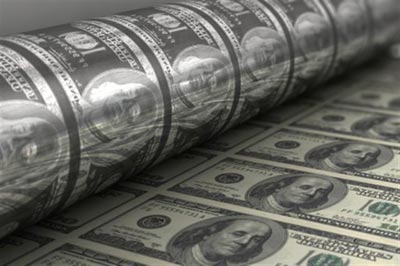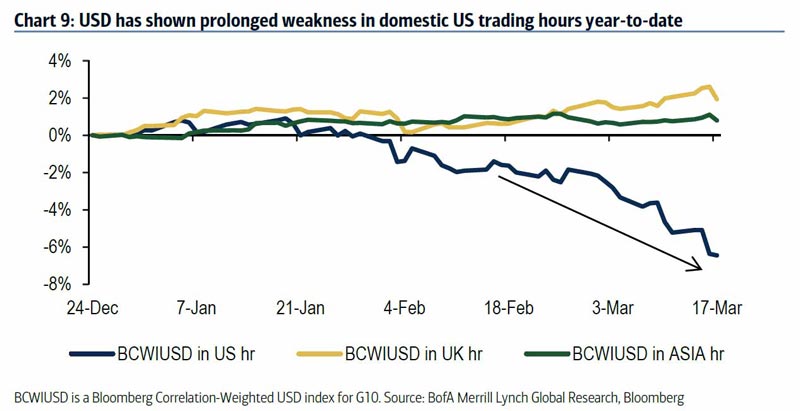A Strange Pattern Emerges When Trading The US Dollar In 2016
Tyler Durden
 One of the more surprising market developments of 2016 has been the violent obliteration of those who had taken part in the biggest consensus trade of 2015, namely long the USD. As the Fed finally admitted earlier this week, the US economy is sputtering and is woefully incapable of handling 4 rate hikes, or 3 for that matter. In fact, the Fed will be lucky to push through even one more rate hike without the Chinese Yuan collapsing and unleashing even more capital outflows (which precipitated the major market swoons in the summer of 2015 and early 2016) arguably the main topic during the alleged Shanghai G-20 "central bank accord." The result: this week saw the biggest two-day USD collapse against a basked of foreign currencies in years, and currently the DXY is trading at a lower level than a year ago. One of the more surprising market developments of 2016 has been the violent obliteration of those who had taken part in the biggest consensus trade of 2015, namely long the USD. As the Fed finally admitted earlier this week, the US economy is sputtering and is woefully incapable of handling 4 rate hikes, or 3 for that matter. In fact, the Fed will be lucky to push through even one more rate hike without the Chinese Yuan collapsing and unleashing even more capital outflows (which precipitated the major market swoons in the summer of 2015 and early 2016) arguably the main topic during the alleged Shanghai G-20 "central bank accord." The result: this week saw the biggest two-day USD collapse against a basked of foreign currencies in years, and currently the DXY is trading at a lower level than a year ago.
However, to say that the dollar selloff is a development would be incorrect: as Bank of America points out, Dollar selling has been going on for the past three months.
But what is more curious is when during the day this selling has taken place.
As Bank of America's FX quant strategist, Vadim Iaralov writes, "ahead of the Fed, the USD was already trending lower against 8 out of 9 G10 currency pairs with GBP being the only exception. The surprisingly-dovish Fed has only further accelerated the decline in the US dollar. The decline started in late January and has occurred during the critical local New York trading hours. The US hours downtrend looks likely to continue in the near future."
What becomes immediately visible when one looks at the chart below is that all of the USD selling in 2016 has taken place during US hours.

This, according to BofA chief FX strategist, Athanasios Vamvakidis means that "the market moves would be consistent with EM central bank interventions."
Perhaps: if true it would suggest that some very notable "EM" central banks (a polite euphemism for the PBOC) have been dumping the USD during US hours, which in turn would explain the coordinated attack against the USD - now with Fed participation - ever since the Shanghai G-20 meeting (although it would not explain why Japan or Europe would be willing to piggyback on this trade as while China wants a weaker dollar, Europe and Japan want the USD as strong as possible).
Whatever the reason, and whoever may be causing this odd temporal divergence, thanks to BofA's observation an interesting arb emerges: buy the USD during Asia and UK hours, and sell during the US day, sit back and collect the profit.
Then again, now that this trade has been exposed and every FX trader sure to jump on it, we would expect precisely the opposite to take place: dollar strength during US hours offset by weakness during the rest of the trading day. We will update readers when the temporal regime changes, which we are confident it will in the not too distant future.
 our mission: our mission:
to widen the scope of financial, economic and political information available to the professional investing public.
to skeptically examine and, where necessary, attack the flaccid institution that financial journalism has become.
to liberate oppressed knowledge.
to provide analysis uninhibited by political constraint.
to facilitate information's unending quest for freedom.
our method: pseudonymous speech...
Anonymity is a shield from the tyranny of the majority. it thus exemplifies the purpose behind the bill of rights, and of the first amendment in particular: to protect unpopular individuals from retaliation-- and their ideas from suppression-- at the hand of an intolerant society.
...responsibly used.
The right to remain anonymous may be abused when it shields fraudulent conduct. but political speech by its nature will sometimes have unpalatable consequences, and, in general, our society accords greater weight to the value of free speech than to the dangers of its misuse.
Though often maligned (typically by those frustrated by an inability to engage in ad hominem attacks) anonymous speech has a long and storied history in the united states. used by the likes of mark twain (aka samuel langhorne clemens) to criticize common ignorance, and perhaps most famously by alexander hamilton, james madison and john jay (aka publius) to write the federalist papers, we think ourselves in good company in using one or another nom de plume. particularly in light of an emerging trend against vocalizing public dissent in the united states, we believe in the critical importance of anonymity and its role in dissident speech. like the economist magazine, we also believe that keeping authorship anonymous moves the focus of discussion to the content of speech and away from the speaker- as it should be. we believe not only that you should be comfortable with anonymous speech in such an environment, but that you should be suspicious of any speech that isn't.
www.zerohedge.com
|




